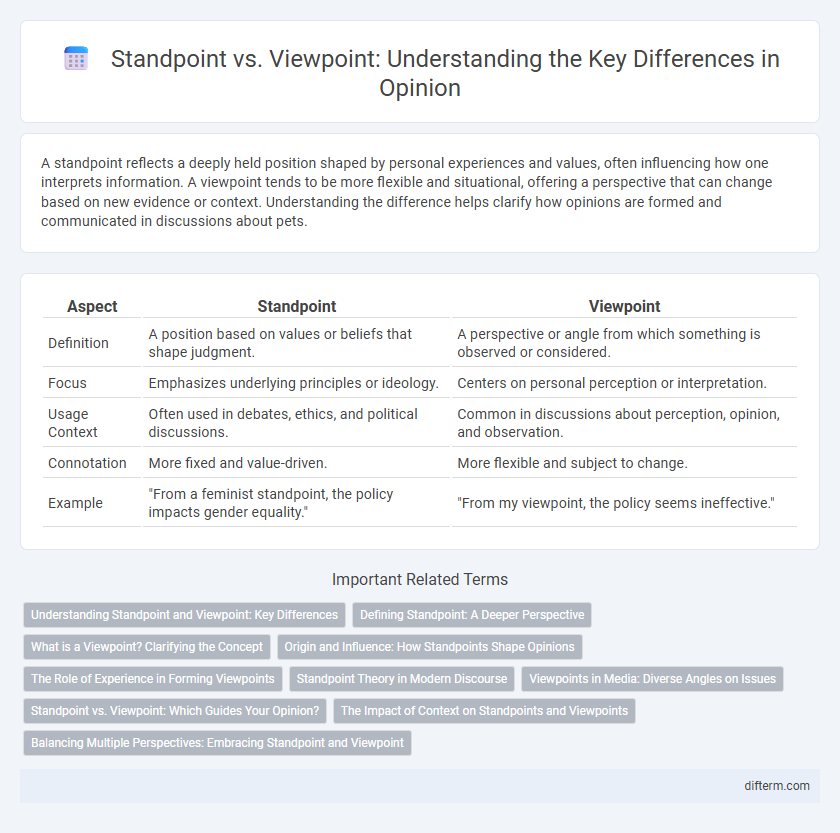A standpoint reflects a deeply held position shaped by personal experiences and values, often influencing how one interprets information. A viewpoint tends to be more flexible and situational, offering a perspective that can change based on new evidence or context. Understanding the difference helps clarify how opinions are formed and communicated in discussions about pets.
Table of Comparison
| Aspect | Standpoint | Viewpoint |
|---|---|---|
| Definition | A position based on values or beliefs that shape judgment. | A perspective or angle from which something is observed or considered. |
| Focus | Emphasizes underlying principles or ideology. | Centers on personal perception or interpretation. |
| Usage Context | Often used in debates, ethics, and political discussions. | Common in discussions about perception, opinion, and observation. |
| Connotation | More fixed and value-driven. | More flexible and subject to change. |
| Example | "From a feminist standpoint, the policy impacts gender equality." | "From my viewpoint, the policy seems ineffective." |
Understanding Standpoint and Viewpoint: Key Differences
Standpoint refers to a position shaped by social, cultural, or personal contexts influencing perception and interpretation, while viewpoint denotes an individual's specific perspective or opinion on a matter. Understanding the distinction helps clarify that standpoint embodies deeper ideological or experiential factors, whereas viewpoint reflects immediate judgments or attitudes. Recognizing these differences enhances communication by acknowledging underlying influences behind expressed opinions.
Defining Standpoint: A Deeper Perspective
A standpoint offers a deeper perspective shaped by personal experiences, social positions, and cultural backgrounds, influencing how individuals interpret information and events. Unlike a viewpoint, which may represent a surface-level opinion, a standpoint provides a foundational framework that underlies and informs one's interpretations. This deeper perspective allows for richer, more nuanced analyses and fosters empathetic understanding across diverse contexts.
What is a Viewpoint? Clarifying the Concept
A viewpoint refers to an individual's perspective shaped by personal experiences, beliefs, and emotions, reflecting how they interpret specific situations or ideas. Unlike a standpoint, which often implies a more formal or collective position based on social or ideological frameworks, a viewpoint centers on subjective perception and interpretation. Understanding what a viewpoint entails highlights the diversity in opinions and emphasizes the importance of considering different personal angles in discussions.
Origin and Influence: How Standpoints Shape Opinions
Standpoints originate from an individual's social background, cultural experiences, and personal values, fundamentally shaping how opinions are formed and expressed. Unlike viewpoints, which can be more neutral or flexible, standpoints are deeply entrenched perspectives influenced by one's positionality within social structures. These entrenched positions determine how information is interpreted and which issues are prioritized, illustrating the power of origin and influence in shaping opinions.
The Role of Experience in Forming Viewpoints
Experience shapes viewpoints by providing a unique context through which individuals interpret information and events. Unlike a fixed standpoint, viewpoints evolve as people acquire new experiences that challenge or reinforce their beliefs. This dynamic interplay between experience and perspective underscores the importance of openness in evaluating opinions.
Standpoint Theory in Modern Discourse
Standpoint Theory in modern discourse emphasizes that knowledge and truth are shaped by social positions and lived experiences, making standpoint a more dynamic and contextually rooted concept than viewpoint. While viewpoint refers to a person's visual or mental perspective, standpoint incorporates power relations and social structures that influence perception and interpretation. This theoretical approach critically challenges traditional objectivity by asserting that marginalized groups provide valuable insights grounded in their unique standpoints.
Viewpoints in Media: Diverse Angles on Issues
Viewpoints in media shape public perception by offering diverse angles on issues, reflecting a range of social, political, and cultural perspectives. Unlike a fixed standpoint, which implies a more rigid, personal position, viewpoints present fluid interpretations that adapt to new information and audience engagement. This diversity enhances critical thinking, allowing audiences to evaluate multiple sides and form balanced opinions.
Standpoint vs. Viewpoint: Which Guides Your Opinion?
Standpoint centers on the deeper social or personal context shaping one's perspective, while viewpoint refers to the immediate angle or opinion expressed. Understanding the distinction clarifies how individual experiences influence interpretations and judgments. Recognizing whether your opinion stems from a standpoint or viewpoint enhances critical thinking and communication effectiveness.
The Impact of Context on Standpoints and Viewpoints
Standpoints shape opinions by reflecting one's social position and experiences, while viewpoints represent individual perspectives influenced by knowledge and beliefs. Context heavily influences both, as cultural background, situational factors, and social dynamics alter how standpoints form and how viewpoints are interpreted. Understanding the impact of context reveals the fluidity of opinions and encourages empathy in discussions across diverse perspectives.
Balancing Multiple Perspectives: Embracing Standpoint and Viewpoint
Balancing multiple perspectives requires recognizing the distinction between standpoint and viewpoint, where standpoint reflects an individual's social position influencing their interpretation, while viewpoint represents a broader outlook shaped by personal experiences. Embracing both concepts enhances critical thinking and fosters empathetic understanding across diverse social contexts. Integrating standpoint and viewpoint cultivates inclusive dialogue and more nuanced opinion formation in complex debates.
standpoint vs viewpoint Infographic

 difterm.com
difterm.com